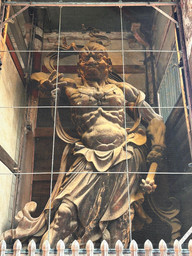The Dark Mystique of Dvarapalas
- Shannon
- Sep 23
- 4 min read
Guardians of the Threshold
Right across the ancient temples of Asia, monstrous figures stand in unwavering vigilance, their stone forms frozen in eternal watch. These are the Dvarapalas, wardens of the sacred gates, whose presence is as unnerving as it is protective. From the grand corridors of Angkor Wat in Cambodia to the volcanic temples of Java and Bali and the sanctuaries of India and Japan, Dvarapalas loom over entrances, their grimacing faces and muscular bodies warning all who approach: the sacred is not for the unworthy. Their silent threat is unmistakable. Crossing their gaze without respect is to flirt with danger both physical and spiritual.

The Demonic Origins of Vigilance
The etymology of Dvarapala, literally “door guardian” in Sanskrit, hardly captures the weight of their role. These figures are not mere gatekeepers, they are liminal beings, existing between the mortal and divine, the living and the supernatural. Some myths claim that certain Dvarapalas were once demons or malevolent spirits subdued and bound by divine command, cursed to eternal vigilance. In every bulging eye, every coiled muscle and every bared tooth, they carry the memory of their past ferocity, a latent threat contained in stone yet still palpable to anyone who dares enter.
Where Gods Entrust Their Fury
In Cambodia, Dvarapalas guard the thresholds of Angkorian temples with an imposing presence. Often wielding maces or clubs, they combine martial authority with supernatural menace. Some are adorned with ceremonial crowns or intricate jewellery, a disturbing juxtaposition of refinement and terror. Pilgrims and visitors alike are reminded through these guardians that the temple is more than architecture, it is a consecrated space demanding reverence and the consequences of arrogance are severe. Their stony gaze seems to follow every movement, a silent enforcement of moral and spiritual order.
Stone Sentinels of the Archipelago
Across Indonesia, from Borobudur to Prambanan and the sacred sanctuaries of Bali, Dvarapalas adopt forms as grotesque as they are awe inspiring. Many are carved with exaggerated features, eyes that bulge unnaturally, teeth jagged and fierce, hands clutching weapons that seem poised to strike. Balinese Dvarapalas, in particular, are intertwined with living ritual, receiving offerings to honour their power and reinforce the boundary between human and divine realms. In these islands, the guardians are not static, they are an active, almost sentient presence, reminding visitors that the sacred world is constantly watched and defended.

Fearsome Protectors of Dharma
In India, Dvarapalas frequently appear at the entrances of Hindu and Buddhist temples, reflecting a dual symbolism of protection and karmic law. They are more than sentries, they embody cosmic order itself, a living reminder that actions have consequences and that only those aligned with dharma may safely pass. Their fearsome forms are a psychological as well as spiritual barrier, designed to instill awe and obedience in equal measure. These figures remind the faithful that the divine world is not merely accessible, it is guarded and the price of disrespect can be catastrophic.

Guardians of the Veil
The sense of liminality that Dvarapalas evoke is central to their power. They inhabit the threshold between worlds, neither fully human nor fully divine, their forms charged with the weight of unseen forces. Folklore suggests that some move when unobserved, patrolling temple grounds at night when the veil between realms is thinnest. In these moments, the boundary between myth and reality becomes unsettlingly fragile and the guardians’ presence is felt in the tightening of the air, the shadows cast in flickering torchlight and the almost imperceptible hum of ancient authority.
Immortal Eyes of Judgement
Even in the modern era, Dvarapalas retain a formidable presence. Tourists may photograph their grotesque features or marvel at their intricate craftsmanship, yet local rituals continue to honour these guardians, offering incense, flowers and prayers. Their stony visages are not inert, they are conduits of spiritual authority and the reverence shown to them reflects a fear that is far from symbolic. Across Asia, these guardians persist as reminders that sacred spaces are defended not merely by walls or locks but by forces older, darker and infinitely more vigilant than any human custodian.

Keepers of Consequence and Darkness
Ultimately, Dvarapalas are eternal sentinels of awe and dread, stretching from India to Cambodia to Indonesia. They are the embodiment of thresholds, the living memory of divine protection and the dark poetry of sacred vigilance. Every bared tooth, every carved muscle and every threatening gaze tells a story of power, fear and cosmic order. To pass beneath a Dvarapala is to acknowledge that the sacred is dangerous, that the line between protection and threat is razor-thin and that some gates are guarded by forces that will not forgive carelessness or arrogance. In their enduring presence, the temples of Asia whisper the same warning across centuries. Respect the threshold or face consequences that are as eternal as the stone guardians themselves.
Thanks for reading The Dark Mystique of Dvarapalas. Check out more awesome legends and amazing destinations here!

Across Asia’s sacred ruins, the dark mystique of the Dvarapalas endures, their colossal forms carved by hands long claimed by time







































